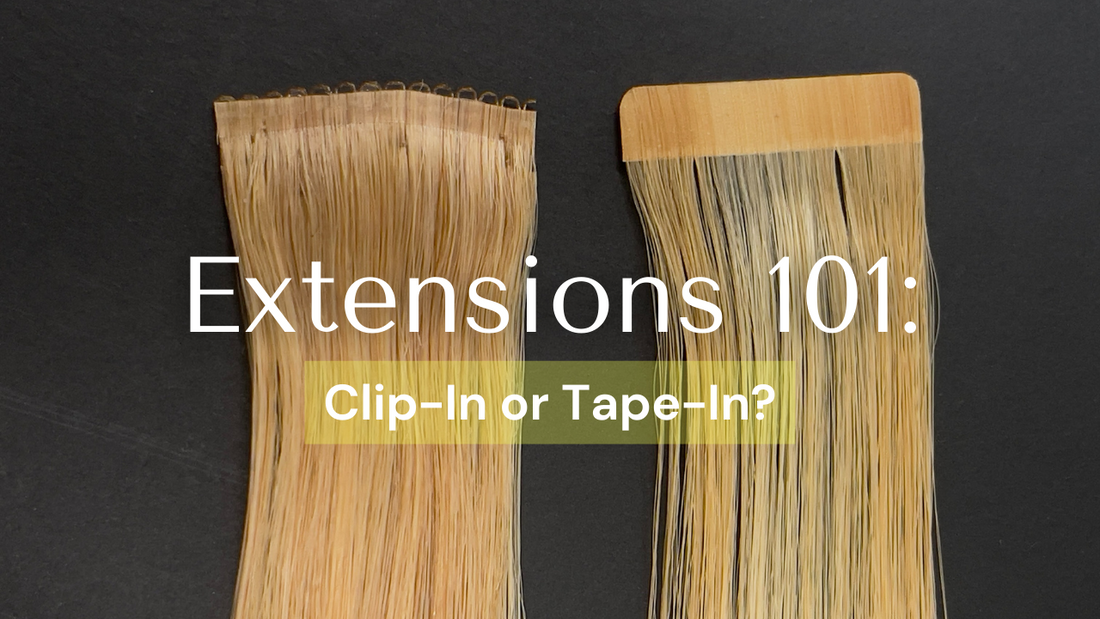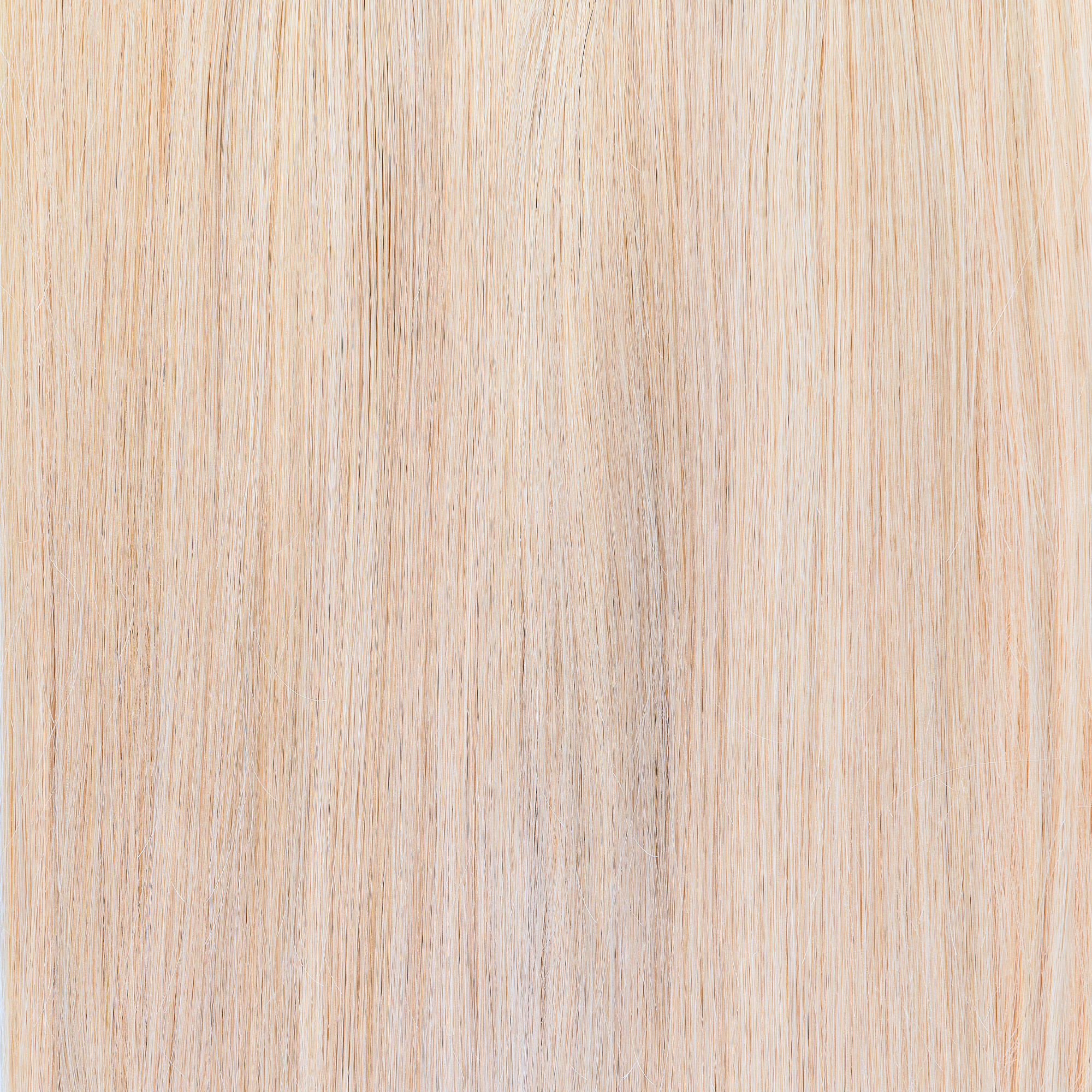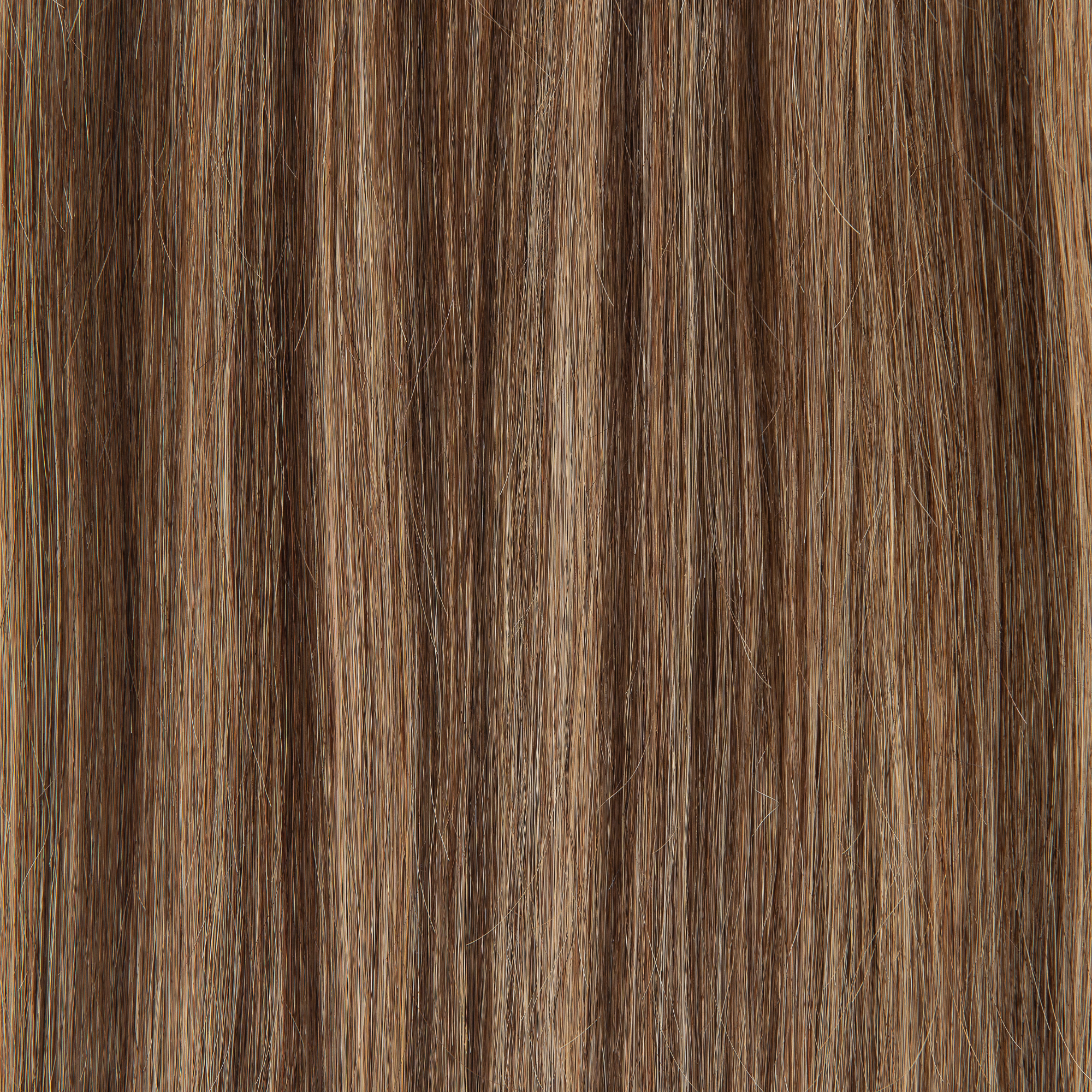
Clip-in vs Tape-in: Decoding the Different Types of Hair Extensions
- Irene GilmanEver wondered which hair extension type suits your lifestyle best—clip in vs tape in hair extensions? You're definitely not alone. Choosing between tape in or clip in hair extensions can be a little confusing, but fear not! Let’s break down the essentials, from style flexibility to maintenance, so you can slay all day, every day.
The Basics: Clip-in, Tape-in
Clip-in Hair Extensions

Clip-in extensions offer a quick and easy way to add extra volume or length without permanent commitment. There are two primary styles of clip-ins: classic weft and seamless wefts.
-
Classic Weft: These extensions are made with a fabric-stitched base, attaching to your hair with small clips. They're great for adding volume and work well for those with thicker hair.
- Seamless Wefts: A lighter, thinner option where the hair is bonded to a thin, silicone-based strip that lies flat against the head, making them virtually undetectable. Seamless wefts are ideal for people with fine hair or for those who want a more natural look. Atelier Hair Extensions proudly offers high-quality seamless wefts, ensuring a flawless blend with your natural hair.
Tape-in Extensions

Tape-in hair extensions consist of real hair segments attached via an adhesive strip, offering a more permanent style. These extensions are applied by placing your natural hair between two adhesive strips, creating a bond that can last for four to eight weeks. The tape bonds are designed to be thin and lightweight, providing a comfortable wear and a natural appearance that meshes seamlessly with your natural hair.
Pros and Cons: Clip-in Extensions
Clip-in hair extensions are particularly appealing for those who value time. Their simple application means you can achieve a salon-quality look in minutes, making them perfect for last-minute events

Pros:
- Flexibility: Easily put in and taken out at home, clip-ins allow for quick style changes.
- Less Damage: Since they are not worn continuously, they typically cause less stress and damage to natural hair.
- Cost-Effective: No need for professional installation or removal, making them a more economical choice.
Cons:
- Temporary: They must be removed before swimming, sleeping, or showering.
- Visible Wefts: If not placed properly, clips and wefts can be visible, especially if the hair is very fine.
- Can Feel Heavy: Particularly fabric weft extensions can feel heavy and uncomfortable during prolonged use.
Pros and Cons: Tape-in
Tape-in extensions offer a semi-permanent solution that blends beautifully with natural hair, promoting a consistently voluminous and lengthy style.

Pros:
- Natural Look: They are less visible in the hair, providing a more natural blend.
- Lightweight: The thin nature of the tape wefts makes them comfortable and light to wear.
- Durable: With proper care, they can last from four to eight weeks before needing reapplication.
Cons:
- Maintenance: Requires professional application and removal, which can add up in cost.
- Potential for Damage: Incorrect application or removal can lead to hair damage.
- Less Styling Versatility: High heat or oils can loosen the tape, which might limit styling options.
Difference Between Tape-in and Clip-in Hair Extensions

Choosing between clip in vs tape in hair extensions involves understanding their distinct characteristics, installation methods, and how they impact everyday wear. This section delves deeper into the nuances of each type, covering aspects like installation, durability, style versatility, comfort, maintenance needs, cost, and the potential for hair damage. Our goal is to equip you with a comprehensive comparison to help you make an informed decision tailored to your lifestyle and hair care needs.
Installation Process Comparison
Tape-in extensions require a professional stylist for application. The process involves sectioning the hair and carefully placing the tape strips to sandwich natural hair. This method requires precision to ensure the weight is evenly distributed, preventing strain on natural hair. Clip-in extensions offer a DIY alternative, perfect for those seeking a non-permanent option. These can be quickly clipped into place at various positions around the head, allowing for full control over the placement and style.
Durability and Longevity
Clip in extensions vs Tape in? Tape-in extensions are generally considered more permanent compared to other types of extensions and can be worn continuously for four to eight weeks before requiring re-application. Because they are more permanent, it's crucial to ensure you're using 100% human hair, especially since you will be sleeping in them. Sleeping can cause wear and tear, and if the extensions are not of great quality, this can significantly affect your experience and the overall lifespan of the extensions. On the other hand, clip-in extensions, when maintained correctly, can last for years. Their longevity stems from the ability to remove them when not in use, thereby minimizing potential damage from daily wear and environmental factors.
Styling Versatility
Clip-in extensions truly shine when it comes to flexibility. You can easily tweak the volume by adding or removing wefts to suit your style for the day. Adjusting the placement of these extensions is a breeze too, which means you can always position them in a way that feels comfortable and looks seamless. Whether you're aiming for a high ponytail for brunch or a sophisticated updo for an evening event, clip-ins cater to all your style needs with zero hassle.
On the other hand, Tape-in extensions, while fantastic for a consistently lush look, do have their styling limitations. Since they are applied near the roots and typically in rows, your options are a bit more restricted. Loose hairstyles or low buns are usually the go-to, helping to keep the tapes discreetly hidden. When it comes to styling with heat tools or applying products, it's crucial to steer clear of the tapes. Avoid direct heat and keep oils away from the base to maintain the bond strong and intact. With tape-ins, it’s all about enjoying a gorgeous, fuller look with a touch of care to keep everything in perfect shape.
Maintenance Requirements
Maintenance is more intensive for Tape-in extensions. They require special shampoos and careful washing techniques to avoid loosening the adhesive. Clip-ins are comparatively easy to maintain. They can be removed before activities such as swimming or sleeping, which reduces potential wear and tear and simplifies the cleaning process.
Cost Analysis
Understanding the financial commitment between clip in or tape in hair extensions in is crucial for making an informed decision that fits your budget and beauty needs.
Clip-in Extensions: These are more budget-friendly initially, as they do not require professional installation. You can easily apply them yourself, saving on salon costs. Clip-ins are also durable, lasting several years with proper care, which involves regular cleaning and safe storage. The upfront cost might be noticeable, but when spread over their lifespan, the investment becomes quite economical.
Tape-in Extensions: These involve a higher initial cost because they require both the purchase of high-quality hair and professional application. This type of extension needs professional maintenance every six to eight weeks to adjust to hair growth, adding to the ongoing cost. While tape-ins are less frequent in replacement compared to clip-ins, the continuous need for professional upkeep makes them pricier over time.
In essence, while tape-in extensions provide a lasting, low-maintenance solution, they come with recurring professional expenses. Clip-in extensions, on the other hand, offer a more cost-effective approach in the long run due to minimal maintenance needs and the flexibility to reuse them extensively. Choosing the right type depends on weighing these costs against your lifestyle and how often you plan to wear your extensions.
Damage Potential: Which is Safer?
Are tape in or clip in extensions better? Clip-in extensions typically present less risk to natural hair since they do not involve any adhesives and can be removed daily, reducing the strain on hair. Tape-in extensions, if not applied or removed correctly, can lead to tension and stress on the hair, potentially causing breakage and thinning over time.
@chinaarae Replying to @samantha.jean.buchholz @dooreshair ♬ original sound - China Rae
By understanding what's the difference between clip in vs tape in hair extensions and the detailed differences between tape in vs clip in hair extensions and clip in vs tape in extensions, you can better choose the option that aligns with your personal needs, ensuring a satisfying and safe hair enhancement experience.
F.A.Q's
Clip-in hair extensions are temporary, versatile, and can be easily clipped in and out of your hair as needed. They are great for occasional use, adding volume, and changing your hairstyle quickly. Tape-in hair extensions, on the other hand, are semi-permanent and involve adhesive strips that tape the extensions to your natural hair. They offer a more seamless look and are ideal for longer-term wear.
When considering clip in vs tape in hair extensions for daily wear, tape-in extensions are generally a better option due to their long-lasting nature and natural appearance. They lie flat against the scalp, making them less noticeable than clip-ins, which can be bulky if not applied correctly. However, clip-ins are perfect for those who want flexibility and the ability to change their look frequently without commitment.
For fine hair, tape-in extensions are often preferred because they are lightweight and less likely to cause damage or strain on the hair. The tape-in method distributes weight evenly across the head, reducing the risk of breakage. Clip-in extensions can be used on fine hair, but it’s important to be gentle and avoid overloading the clips with too much hair, as this can cause tension and damage.
Choosing between tape in or clip in hair extensions depends on your lifestyle, budget, and hair goals. If you're looking for a non-committal, easy-to-use option for special occasions or occasional volume, clip-ins are a great choice. For a more natural and long-lasting solution that blends seamlessly with your hair, tape-ins are the way to go. Consider how often you want to wear extensions, your comfort with styling them, and whether you're willing to visit a salon for application and maintenance.
Clip-in extensions require minimal maintenance; you can remove them daily and store them properly, ensuring they stay in good condition. They should be washed and conditioned occasionally, depending on how often you wear them. Tape-in extensions require more maintenance since they are worn continuously. They need to be washed and conditioned carefully to avoid loosening the adhesive. It’s also recommended to have them professionally adjusted every 6-8 weeks as your hair grows.









